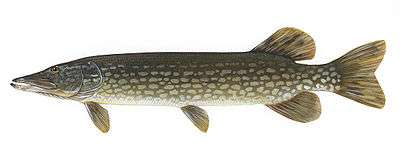Esociformes
The Esociformes are a small order of ray-finned fish, with two families, the Umbridae (mudminnows) and the Esocidae (pikes). The pikes of genus Esox give the order its name. The 10 species are found as five in each family.
| Esociformes | |
|---|---|
 | |
| Northern pike (Esox lucius) | |
| Scientific classification | |
| Kingdom: | Animalia |
| Phylum: | Chordata |
| Class: | Actinopterygii |
| Superorder: | Protacanthopterygii |
| Order: | Esociformes Bleeker, 1859 |
| Families | |
| Synonyms | |
| |
This order is closely related to the Salmoniformes, the two comprising the superorder Protacanthopterygii, and are often included in their order. The esociform fishes first appeared in the mid-Cretaceous — early products of the Euteleost radiation of that time. Today, they are found only in fresh water in North America and the northern Eurasian regions.
Esocidae
The pikes tend to be lie-in-wait, ambush predators, with elongated snouts, long, well-muscled torsos, forked tails, and dorsal and anal fins set well back and opposite each other for rapid acceleration along a straight line, allowing the fish to quickly emerge from cover to capture their prey. Prey capture is facilitated by the impaling of the prey animal on the sharp teeth, after which the pike retreats to cover, turns the prey around, and swallows it, head first.
Anatomically, the pikes are characterized by the presence of shark-like, maxillary teeth, a mesocoracoid, and the absence of an adipose fin, breeding tubercules, and pyloric cecae.
The two more prominent species of Esocidae are Esox lucius, the northern pike, a popular sport fish that may reach lengths as great 1.5 m (4.6 ft), and the muskellunge or "muskie", E. masquinongy, which grows even larger.
Umbridae
Mudminnows are much smaller than the related pikes, with usual lengths of less than 20 cm. However, they are also extremely efficient, lie-in-wait, ambush predators, feeding mostly on the invertebrates commonly found in warm backwaters. Of the three North American species of genus Umbra, one, U. limi, possesses a limited capability for air breathing. Umbra spp. are most commonly found in the Atlantic coast regions of North America, along the marshy, low-oxygen areas of the Mississippi River, and in similar environments in Europe.
References
- Haaramo, Mikko (2007). "Esociformes – pikes, pickerels, mud minnows and blackfishes". Mikko's Phylogeny Archive. Retrieved 30 December 2016.
- Froese, Rainer, and Daniel Pauly, eds. (2004). "Esociformes" in FishBase. October 2004 version.